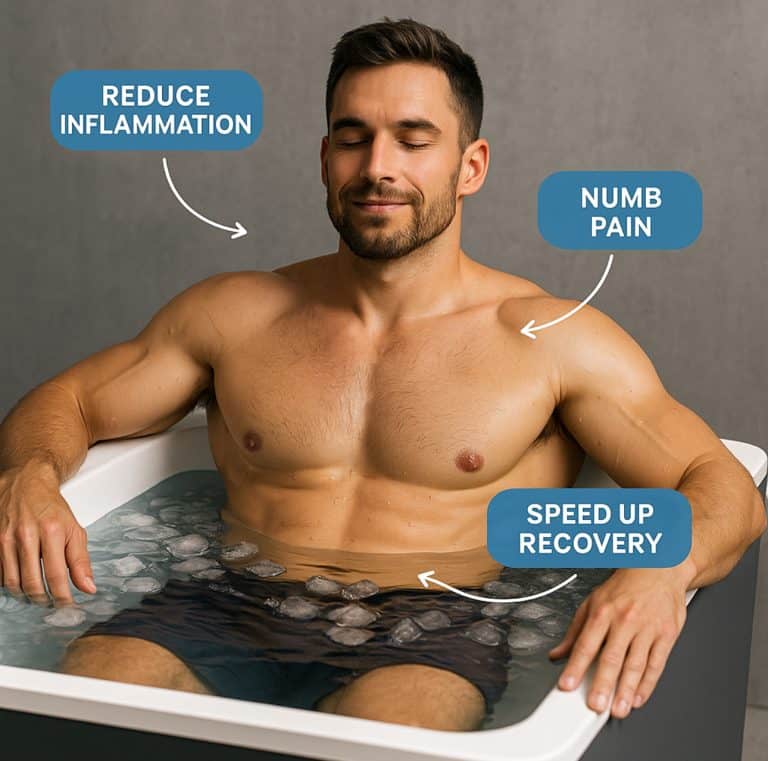Cold Plunge vs Ice Bath: What’s the Difference?

When exploring cold therapy, you’ll often come across two terms: cold plunge and ice bath. At first glance, they might seem interchangeable. But in practice — and performance — they’re quite different. While both forms involve submerging the body in cold water to stimulate recovery, mood, and resilience, they differ significantly in their construction, consistency, convenience, and cost.
In this guide, we’ll break down the difference between a cold plunge vs ice bath, and help you determine which method aligns with your wellness goals, training frequency, and budget.
❄️ What Is a Cold Plunge?

A cold plunge is a purpose-built tub or system designed to maintain water at a consistently cold temperature — typically between 39°F and 55°F — without the need to manually add ice. These systems are engineered with built-in chillers, filtration units, and durable materials that allow for daily use without worrying about water cleanliness or setup time.
Modern cold plunge tubs often feature:
- Digital temperature control
- Continuous water circulation for even cooling
- Built-in UV or ozone filtration systems
- Durable insulated construction for indoor or outdoor use
These systems are designed to support regular cold therapy practices, providing a reliable, clean, and efficient solution that fits easily into a routine.
🛁 What Is an Ice Bath?

An ice bath, on the other hand, refers to a more traditional and manual form of cold exposure. It involves filling a tub — usually a bathtub, stock tank, or even a garbage bin — with cold tap water and then adding ice to reach the desired temperature. Unlike a cold plunge tub, ice baths require significant preparation and cleanup before and after each session.
Common characteristics include:
- No temperature regulation — each session varies
- Manual ice purchase and water refill
- Typically lacks filtration or sanitation
- Difficult to control exposure duration due to temperature fluctuations
Ice baths can be effective for occasional or experimental use but may be impractical for those looking for consistent performance or long-term implementation.
⚖️ Cold Plunge vs Ice Bath: Key Differences
When comparing a cold plunge vs ice bath, several key differences emerge:
| Feature | Cold Plunge | Ice Bath |
| Temperature Control | Accurate, consistent (39–55°F) | Varies with ice amount and environment |
| Filtration | Built-in UV/ozone filters | None; water reused or dumped manually |
| Setup Time | Always ready | Requires setup before each use |
| Maintenance | Simple filter changes | Frequent cleaning and dumping |
| Upfront Cost | $2,000–$6,000+ | $50–$500 |
| Long-Term Cost | Low (no ice or refill needed) | High (ice, water, time investment) |
| Convenience | Plug-and-plunge usability | Labor-intensive process |
Cold plunge tubs provide a user-friendly, maintenance-light option that saves time and provides better hygienic control, especially for households or athletes who plunge daily.

💪 Physical and Mental Benefits

Despite the differences in setup, both cold plunges and ice baths offer similar health benefits when properly applied:
- Reduced inflammation and muscle soreness due to vasoconstriction
- Enhanced circulation and cardiovascular tone
- Increased dopamine and norepinephrine, improving mood and alertness
- Boosted recovery post-exercise, helping reduce DOMS (delayed onset muscle soreness)
- Improved stress resilience through hormetic stress adaptation.
🧰 Installation and Maintenance Considerations
Cold Plunge Tubs:
Cold plunge units typically require a flat, dry surface and access to a grounded electrical outlet. Most models are plug-and-play, and some can be placed indoors or outdoors depending on the insulation and weather protection. Maintenance usually involves basic filter changes and periodic cleaning of the interior tub. Many users only need to change the water every few weeks, thanks to integrated UV or ozone filtration.
Ice Baths:
An ice bath setup can be as simple as a metal trough or as elaborate as a dedicated tank. But the process is manual: fill the container, add ice (often 20–40 lbs per session), stir, and test the water temperature. After the session, the water is typically dumped. This process becomes time-consuming, costly, and inefficient if done more than a few times per week.
💸 Cost Breakdown: Initial vs Ongoing
While ice baths are appealing for their low entry price, the costs can add up. Regular purchases of ice, increased water usage, and time commitment mean that long-term users may actually save by investing in a cold plunge.
| Expense Type | Cold Plunge | Ice Bath |
| Initial Setup | $2,000–$6,000+ | $50–$500 |
| Monthly Ice Cost | $0 | $100–$200 |
| Water Use | Low (recycled/filtered) | High (replaced often) |
| Time Investment | Low | High (setup/cleanup) |
🔬 What the Research Supports
Scientific studies validate both cold plunges and ice baths as effective methods of cold water immersion therapy. Key findings include:
- Reduced soreness and inflammation: A study in the Journal of Physiology showed immersion in water at 50–59°F post-exercise reduced muscle damage markers.
- Hormonal effects: Research published in PubMed Central found that cold exposure increases norepinephrine by up to 530% and dopamine by 250%, which are linked to elevated mood and resilience.
- Immune and metabolic benefits: Cold exposure activates brown fat, boosts metabolism, and improves immune system readiness.
🔗 PubMed – Cold Exposure and Catecholamines
🔗 Cleveland Clinic – Benefits of Cold Water Therapy
🧭 Which One Is Right for You?
So, which is better — a cold plunge or ice bath?
Choose an ice bath if:
- You’re just getting started and want to experiment
- You’re on a tight budget
- You don’t mind setup effort and cleanup
Choose a cold plunge if:
- You plan to use cold therapy multiple times per week
- You value convenience, sanitation, and consistency
- You want long-term cost efficiency and performance
Both methods have their place — but for most regular users, a cold plunge tub is the superior choice.
✅ Continue Your Cold Therapy Journey:
- Best Cold Plunge Tubs of 2025
- Cold Plunge Benefits (Backed by Science)
- How to Use a Cold Plunge Safely
❓ Frequently Asked Questions
1. How cold should the water be for a cold plunge vs an ice bath?
For optimal benefits, most cold-plunge tubs are set between 39 °F and 55 °F. An ice bath will drift as the ice melts; aim to start around 50 °F and allow no warmer than 60 °F during your session.
2. How long should I stay immersed?
Begin with 2–3 minutes and work up to 10–12 minutes per session. Always listen to your body and exit sooner if you feel numbness in the hands, feet, or face.
3. Is there anyone who should avoid cold water immersion?
People with cardiovascular issues, Raynaud’s phenomenon, uncontrolled high blood pressure, or pregnancy should consult a medical professional before starting cold therapy. See the Mayo Clinic guidance for detailed safety notes.
4. Do I need to shower before or after a plunge?
A quick rinse before keeps the water cleaner; a warm shower afterward helps restore normal circulation and comfort.
5. Can I do a cold plunge every day?
Yes—provided you recover well, keep sessions under 15 minutes, and stay within safe temperatures. The built-in chiller and filtration of a cold-plunge tub make daily use practical.






